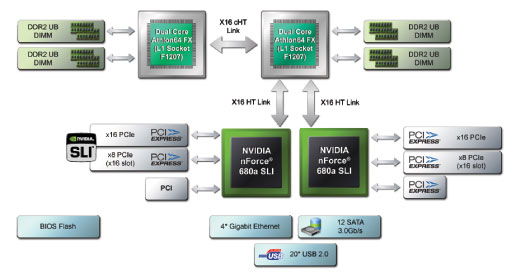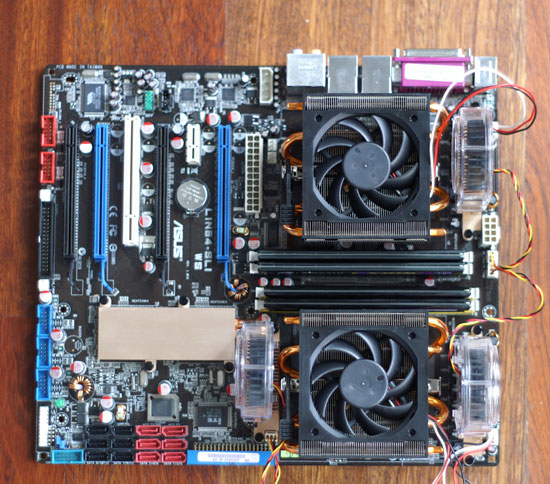AMD's Quad FX: Technically Quad Core
by Anand Lal Shimpi on November 30, 2006 1:16 PM EST- Posted in
- CPUs
The Platform
With the recent ATI acquisition under its belt, AMD has started down the path of becoming a platform company. As such it's almost fitting that the most interesting part of today's story isn't the CPUs, but rather the chipset and motherboard that complete Quad FX.
When AMD first talked about Quad FX as 4x4, everyone assumed that we would be looking at a pair of Socket-AM2 CPUs on a desktop motherboard. However as we got closer to launch it quickly became evident that Quad FX would be using Opteron's new Socket-1207 instead. The reason for using Socket-1207 instead of AM2 is simple; in a single socket AM2 system you only need a single Hyper Transport link between the CPU and the chipset, which is provided for in AM2 CPUs. However, with two sockets you need a minimum of two links, one connecting the two sockets and one for the chipset. It's the number of HT links required that forced the 1207-pin socket upon Quad FX. We will get to how this impacts your upgrade path and CPU costs later, but for now just know that Quad FX only works with 1207-pin Athlon 64 FX CPUs (Opterons are prevented from working in the BIOS).
Despite the ATI acquisition, the only Quad FX chipset available at launch is from NVIDIA. Dubbed the nForce 680a, NVIDIA once again gives us a reason to respect its platform group. Although singular in name, the nForce 680a is composed of two 680a SLI chips, each with a x16 and x8 PCIe slot. One of the two chips has an additional 8 PCIe lanes bringing the total up to 56 lanes, more than any other NVIDIA chipset, including the recently released 680i.

The madness doesn't end with the sheer number of PCIe lanes; the 680a also supports a total of four GigE ports, twelve SATA ports and twenty USB 2.0 ports. All of the usual nForce features are present on the 680a, including SLI support, RAID and NVIDIA's networking (FirstPacket and Teaming support). The chipset is a pure beast and we were eager to see an implementation of all of the PCIe, GigE, SATA and USB ports that the 680a supports on the first Quad FX motherboards; unfortunately we were met with disappointment.

AMD's Quad FX platform is launching with a single motherboard partner, ASUS, and a single Quad FX motherboard: the L1N64-SLI WS. The ASUS board features four physical x16 slots (two x16 and two x8), a single x1 PCIe slot and one regular PCI slot.

You also get all twelve SATA ports, but there's only support for ten USB ports and two GigE ports. Obviously the number of people that will complain about not having all twenty USB ports and four GigE ports are limited, but with AMD expecting the L1N64-SLI WS to retail for around $370, we wanted all of the bells and whistles.

We asked AMD when we could expect other Quad FX motherboard designs but at this point it looks like the ASUS solution is it. AMD is working with more motherboard partners but there's no indication if or when additional Quad FX designs will surface.

AMD is guaranteeing a bit of an upgrade path to early adopters of Quad FX by promising that these motherboards will work with AMD's native quad-core CPUs when they are available next year, meaning you'll get support for eight cores in the same platform in less than a year.










88 Comments
View All Comments
BikeDude - Tuesday, December 5, 2006 - link
Could the reason be that 1GB per memory node is simply too little?On a configuration like this, you'll easily see one of the nodes with only 256MB or so left...
So, put in some more memory! At this point 32-bit XP will be limiting, even for 32-bit apps. (XP won't address more than 2^32 Bytes, some of this will be masked by PCI and PCIe devices, and additionally each process only has a 2GB address space for code&data unless you upgrade to 64-bit Windows) Also be aware that nVidia ForceWare 80.00 and newer lost PAE support. You'll experience crashes and non-working games if combined with a PAE aware 32-bit OS (such as Win2003). ForceWare 79.11 works fine though.
(BTW: MSFT added NUMA support in XP SP2)
Kiijibari - Saturday, December 2, 2006 - link
Hi Ananand,sounds credible, because there is some extra cache snooping traffic going on, anyways, please keep us posted if there is a new BIOS version available, and if it would "do" something :)
Windows schweduler differences between XP and VISTA would be interesting, too.
So far there were only Win32 XP vs. Win Vista64 comparisions, not possible to draw a fair conclusion with that data.
Thanks a lot
Kiijibari
mino - Friday, December 1, 2006 - link
One important question:Are those new FX-7x CPU identical or is there some differentiation employed ???
Kiijibari - Saturday, December 2, 2006 - link
identical to what ?If you meant Socket-F Opterons, then yes, they are identical, if the BIOS allows it, then normal Opterons should be able to run in 4x4 boards, too.
cheers
Kiijibari
mino - Sunday, December 3, 2006 - link
Thanks that info(if correct) pretty much clears the FUD.Griswold - Saturday, December 2, 2006 - link
How so? The 2P+ Opteron IMC wants buffered RAM, while these FX types do not. I dont think a simple BIOS hack can circumvent that.Kiijibari - Saturday, December 2, 2006 - link
*gasp*Du you really think AMD engineers, tests, validate, etc. a CPU for a niche market ??
There are maybe only a few thousand 4x4 CPUs, that are sold worldwide per month ... it would be economical ridiculous.
But if you dont know anything about business, maybe that will convince you:
http://www.aceshardware.com/forums/read_post.jsp?i...">http://www.aceshardware.com/forums/read_post.jsp?i...
cheers
Kiijibari
lollichop - Sunday, February 26, 2017 - link
All idiots talking about old CPUs here :D Fast forward 11 years, Ryzen will be out in a week's time.